Cisco Secure Access Service Edge (SASE) and
Security Service Edge (SSE) Architecture Guide
Available Languages
Bias-Free Language
The documentation set for this product strives to use bias-free language. For the purposes of this documentation set, bias-free is defined as language that does not imply discrimination based on age, disability, gender, racial identity, ethnic identity, sexual orientation, socioeconomic status, and intersectionality. Exceptions may be present in the documentation due to language that is hardcoded in the user interfaces of the product software, language used based on RFP documentation, or language that is used by a referenced third-party product. Learn more about how Cisco is using Inclusive Language.
Today’s workforce expects seamless access to applications wherever they are, on any device. With the rise of remote work, the growing push of company data and infrastructure into the cloud, and the increasing number of cloud applications such as Office 365 and Salesforce utilized by the workforce, the amount of traffic directed to the Internet has increased significantly. The need for cloud-enabled security services expands daily as contractors, partners, IoT devices and more each require network access no matter where they are. IT needs to protect and ensure optimal application performance for users and devices as if they were located at a corporate office or branch. Each requires secure access to applications and must now be treated as a ‘branch of one.’
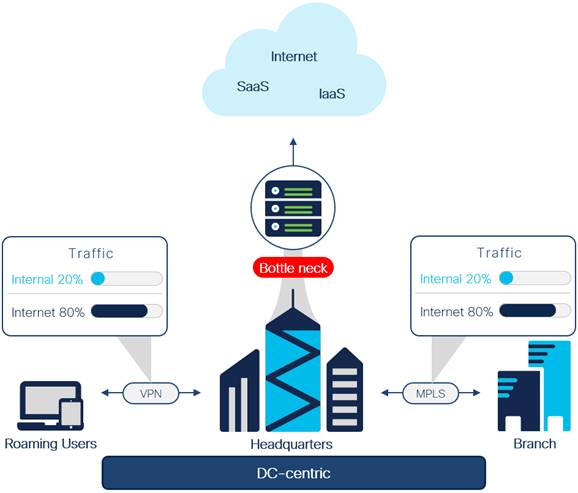
High level DC-Centric Architecture
Because of these changes, the DC-centric model has become costly and inefficient for handling this traffic. Consider the following:
● Remote work and hybrid work are here to stay as people work from anywhere on a continuous basis. This makes user mobility is a paramount capability for modern enterprises
● Distributed users and applications are hard to manage and increase security risk due to a larger attack surface
● There are significant problems with application performance and user experience using traditional networking architectures with modern cloud applications
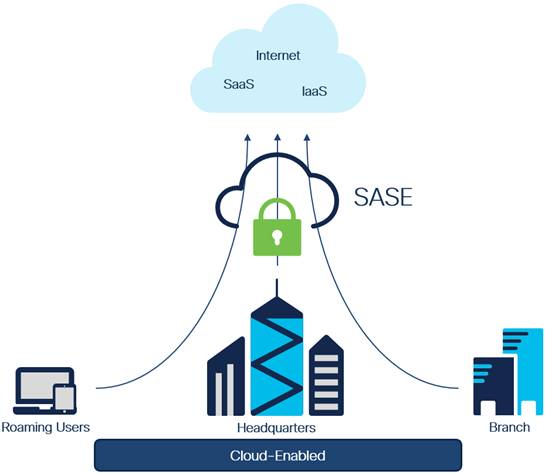
High level SASE Architecture
In this new paradigm, IT requires a simple and reliable approach to protect and connect with agility. This is forcing a convergence of network and security functions closer to users and devices, at the edge—and is best delivered as a cloud-enabled model called secure access service edge (SASE).
In 2019, Gartner published a report called The Future of Network Security Is in the Cloud. In this report, Gartner introduced the SASE concept. Back in 2017, several vendors and analysts in the industry defined a new concept – the secure Internet gateway (SIG). This cloud native solution offers multiple functions including domain name system (DNS) security, secure web gateway (SWG), firewall as a service (FWaaS), and cloud access security broker (CASB) to improve security and performance while reducing costs and maintenance tasks. The SASE concept goes beyond the capabilities found within SIG and includes the convergence of networking functionality as well.
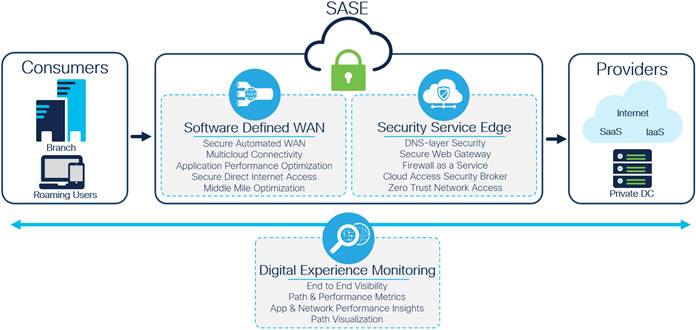
SASE Capability Overview
Cloud computing services offer convenient, pay-as-you-go models that eliminate costly expenditures and maintenance. Cloud providers host a choice of infrastructure, platform, and software offerings on-site that you “rent”, giving your organization the flexibility to turn cloud computing services up and down according to changing requirements. There are three main cloud computing service options:
● Infrastructure-as-a-Service (IaaS): In this model, a cloud provider hosts infrastructure components that are traditionally located in on-premise data centers. With IaaS, your organization can choose when and how you want to administer workloads, without needing to buy, manage, and support the underlying infrastructure
● Platform-as-a-Service (PaaS): This model is one layer of abstraction above IaaS. Cloud providers, in addition to providing infrastructure components, also host and manage operating systems and middleware that your developers need to create and run applications
● Software-as-a-Service (SaaS): With SaaS, cloud providers host and manage an entire infrastructure, as well as end-user applications. When your company chooses a SaaS model, you do not need to install anything; your users will be able to log in and begin immediately using the cloud provider’s application running on their infrastructure
The goal of SASE is to provide secure access to applications and data from your data center or cloud platforms like Azure, AWS, Google Cloud, and SaaS providers based on:
● Identity: limiting application access to specified users and devices
● Context: risk-based assessment to prevent questionable users or compromised/insecure devices from accessing the network
● Least Privilege: limit user and device access to only services that have been defined for their usage
Service edge refers to global point of presence (PoP), IaaS, or colocation facilities where local traffic from branches and endpoints is secured and forwarded to the appropriate destination without first traveling to data center focal points.
The Software Defined WAN (SD-WAN) and Security Service Edge (SSE) components of SASE are primarily delivered as Networking-as-a-Service (NaaS) and Security-as-a-Service (SECaaS) models. This refers to the ability to offer these services as SaaS. By delivering security and networking services together from the cloud, organizations will be able to securely connect any user or device to any application without having to install and maintain the network management and security infrastructure.
Cloud adoption, distributed workforces, and threats have been on the rise for years. As more users connect to company networks from anywhere that has an internet connection, more data is being routed outside of traditional on-premises data centers, creating security gaps that traditional DC-centric network architectures aren’t built to handle.
In 2021, Gartner coined a new concept for businesses who may be ready to transition to cloud security without a complete overhaul of their network architectures SASE requires. This concept is known as Security Service Edge. The SSE architecture is a collection of security functions that can reduce complexity and improve user experience by consolidating multiple disparate security capabilities and delivering them from the cloud. These security functions include, but are not limited to, DNS-layer security, secure web gateway, firewall as a service, cloud access security broker, and zero trust network access.

Security Service Edge Capability Overview
Because of this, organizations have flexibility in determining whether to deploy SSE or move towards a full SASE deployment. The answer may vary by each organization’s own unique needs. For organizations with a hybrid workforce, however, when the additional security features of SSE are paired with the enhanced connectivity features of SASE, the organization gets a holistic solution that protects uses and devices from threats while boosting network performance. A full SASE solution makes it easier than ever to scale up or down an increasingly distributed workforce. While moving towards SSE may be a first step, journeying beyond SSE to include the network component may be in the best interest of organizations in a hybrid world.
Whether included in an SASE architecture or deployed standalone, a Security Service Edge architecture should:
● Provide secure seamless access for users
● Provide security with consistent policy
● Update threat protection and policies without hardware and software upgrades
● Restrict access based on identity and context
● Increase security staff effectiveness with centralized policy management
DNS-layer Security
DNS resolution is the first step when a user attempts to access a website or other service on the Internet. DNS-layer Security logs and categorizes DNS activity by type of security threat or web content and the action taken, whether it was blocked or allowed.
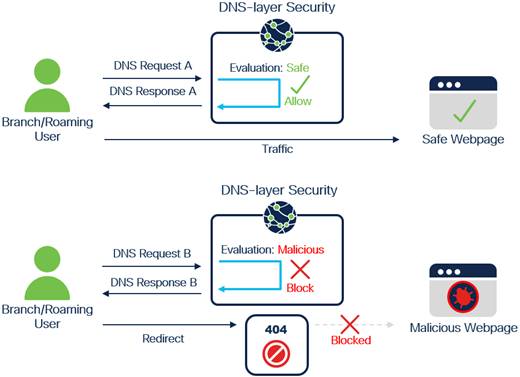
DNS-layer Security Overview
It is critical that the DNS-layer security is underpinned by excellent threat intelligence sources. Threat intelligence itself is not a solution but is a crucial security architecture component. A threat intelligence platform centralizes the collection of threat data from numerous sources and formats and most importantly presents the data in a usable format.
Secure Web Gateway
A cloud-based web proxy or SWG provides security functions such as URL and category filtering and real-time inspection of inbound files for malware and other threats. SSL/TLS decryption is necessary to inspect encrypted web traffic before other certain SWG security capabilities can enforced. Content filtering by category or specific uniform resource locators (URLs) is used to block destinations that violate policies or compliance rules. Remote browser isolation protects users from potential malware and other threats by redirecting browsing to a cloud-based host. This isolation is achieved by serving the web content to users via a remotely spun up surrogate browser located in the cloud.

Secure Web Gateway Overview
Network anti-malware inspects files as they traverse the network, using dynamic threat intelligence to check the disposition of files before they reach the device. File sandboxing is used to open and inspect untrusted files which could compromise an endpoint.
Firewall As a Service
Firewall as a Service (FWaaS) is the cloud-based delivery of firewall functionality to protect non-web Internet traffic. In addition to layer 3-4 filtering, FWaaS typically includes features for intrusion prevention and application-level visibility and control.
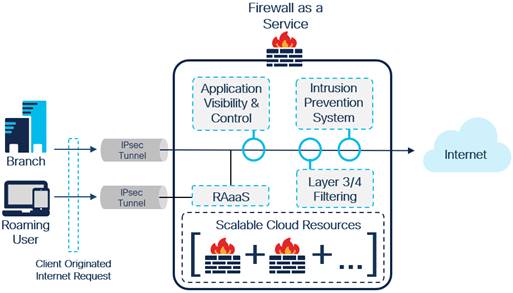
Firewall as a Service Overview
Some of the benefits provided by FWaaS when compared to on-premises firewalls include:
● Scalable due to the pool of resources available to cloud-delivered firewalls allowing easy growth or contraction based on an organization’s need
● Centralized policy management for multiple remote locations
● Easier to deploy and maintain
Remote Access as a Service (RAaaS) provides cloud-delivered VPN services for roaming users covering use cases for applications or services that ZTNA solutions do not support. Like FWaaS, RAaaS provides a scalable alternative to on-premises VPN solutions and in addition to private application access, enables roaming users to receive security capabilities provided by through the FWaaS such as Layer 3-4 traffic filtering and intrusion prevention. RAaaS should still follow zero trust principles, incorporating multi factor authentication (MFA), context checks, and least privilege access to private applications.
Cloud Access Security Broker
Cloud access security brokers help control and secure the use of SaaS applications. The value of CASBs stems from their capability to give insight into cloud application usage across cloud platforms and to identify unsanctioned use. CASBs use auto discovery to expose shadow IT, detecting and reporting on the cloud applications that are in use across the network.
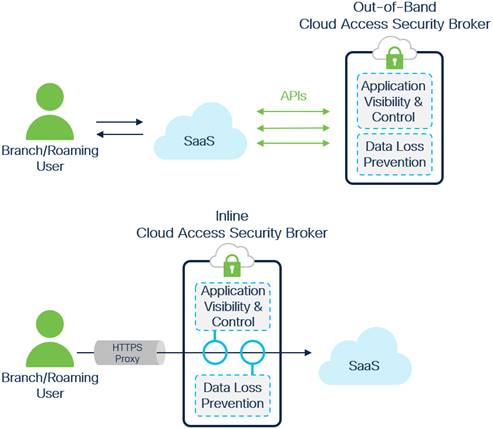
Cloud Access Security Broker Overview
A vital ability of CASB is data loss prevention (DLP) - the capability to detect and provide alerts when abnormal user activity occurs to help stop both internal and external threats.
Although included as part of CASB, inline DLP warrants its own mention and provides data security for user traffic traversing the Internet or traversing data centers to utilize private applications. A common CASB deployment is to install out of band and to provide API based DLP functionality. For increased security, DLP should be implemented as a standalone inline feature of the SASE security stack to catch sensitive information as it passes through the network. This can then be supplemented with DLP capabilities built into a CASB.
Zero Trust Network Access
In a DC-centric model roaming users are provided remote access to resources using full tunnel VPN, redirecting all traffic, internal and internet destined, to the data center. Scalability issues can arise as users shift between on-premises and remote work and VPN appliances are starved for resources. User experience suffers as backhauled traffic causes high latency and users must enter credentials numerous times during the workday creates password exhaustion. In a cloud-enabled model, access can be provided to private or public applications leveraging a clientless or client based zero trust network access solution.
Zero Trust security takes a “never trust, always verify” approach to security. To do this, it is essential to verify identity and context. Identity is determining who a user is. Traditional identity checks use passwords, but these can be stolen, or brute forced making password-only identity checks unreliable forms of identity verification. Context is the use of supplemental information to improve security decisions at the time they are made according to Gartner. This supplemental information may include, but is not limited to, OS version, browser version, firewall status, and location. An assessment is done based on this information to determine if access should be allowed to the application based on the calculated risk. For example, the security policy for a restricted application could require the user to use an updated browser not susceptible to certain vulnerabilities. ZTNA verifies a user’s identity and context before granting least privilege access to permitted applications using a trust broker, which is a system that facilitates identity and context checks against users and restricts visibility and access to applications based on a configured policy.
After identity and context are verified, least privilege access is given based on granular policy rules and the user only has visibility and access to applications they are authorized to. This access is segmented on a per-application basis at layer 7 in the OSI model, limiting a potential attacker’s lateral movement within the network and containing breaches. Because only traffic specific to the authorized application traverses the ZTNA solution rather than all client traffic, the overall remote user experience is improved.
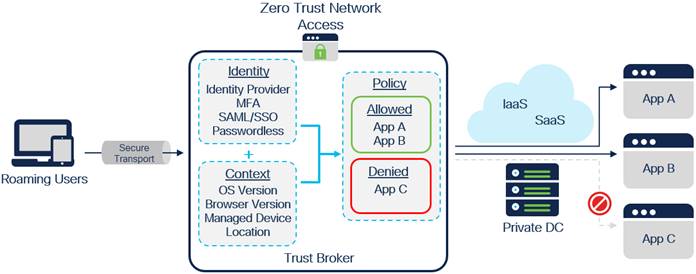
Zero Trust Network Access Overview
As mentioned earlier, traditional identity checking may only use passwords can be unreliable. ZTNA requires a strong, cloud-based, multi-factor authentication solution that ensures users are verified before granted access to specified resources. User experience can be further improved using SAML/SSO or passwordless authentication capabilities helping mitigate password exhaustion and poor security habits. ZTNA solutions typically take the form of a reverse proxy for clientless ZTNA access via a browser or a software agent for client based ZTNA access. While clientless ZTNA solutions can provide seamless access to users with managed and unmanaged devices, client based ZTNA solutions offer enhanced security using additional device and policy checks available with software agents.
A traditional DC-centric network model made sense when the enterprise data center was the primary destination for users to access applications and data across the network, however, the wide-scale use of cloud applications has become fundamental to business operations at all locations. The centralized security approach has also become impractical because of the high cost of backhauling traffic and the resulting performance issues at remote locations.
To overcome these costs and performance issues, many organizations are adopting a more decentralized networking approach to optimize performance, otherwise known as direct Internet access (DIA). DIA is an architecture component in which certain Internet-bound traffic or public cloud traffic from the branch can be routed directly to the Internet, thereby bypassing the latency of tunneling Internet-bound traffic to a central site. The goal of SASE is to connect users and devices, regardless of location, to any application across any cloud. A secure automated WAN is used to optimize performance by ensuring the fastest, most reliable and secure path to the cloud.
Configuring multiple routers connected to different circuits (for example, an MPLS link and a broadband Internet link) to route network traffic efficiently and optimally can be challenging. Beyond simple load balancing, available bandwidth capacity may go unused during periods of congestion. For example, your broadband Internet connection may be running slowly during a given period of time, while your costly MPLS link is relatively uncongested and may actually be able to provide faster Internet connectivity. The inability to aggregate disparate links means wasted bandwidth capacity and lower employee satisfaction.
SD-WAN combines and optimizes traditional WAN technologies, such as MPLS and broadband Internet connections. This allows organizations to efficiently route network traffic to multiple remote branch locations while providing enhanced monitoring and management capabilities. SD-WAN monitors network traffic across all available links in real-time and dynamically selects the best route for each data packet traversing the network. Additionally, through direct peering relationships to cloud providers middle mile optimization reduces overall hop counts, which reduces latency and improves the overall user experience when accessing applications.

SD-WAN Overview
The SD-WAN component of a SASE architecture should have the following qualities:
● Flexible, as a service WAN management for on-premises, cloud, and multitenant environments
● Route traffic across different links (MPLS, Internet, 5G, etc.) based on destination
● Route traffic across different links based on cost
● Aggregate multiple links to provide greater total bandwidth
● Rerouting traffic across an alternate link when a link is congested, unstable, or down
● Prioritizing certain application traffic to ensure quality of service
With the rise of remote work, employees are now connecting to enterprise services, applications, and networks from distributed locations both within and outside of the corporate perimeter. Moving from a DC-centric architecture using legacy WANs and security architectures to a cloud-enabled SASE or SSE architecture increases agility, resilience, and performance. But with this change, organizations are challenged to deliver reliable application performance because of the increased external dependencies in the new enterprise ecosystem that they don’t own or control. When something goes wrong, network teams often carry the burden of proving the network innocent with no visibility into end-to-end dependencies, such as ISP networks or SaaS application performance. This leads to wasted resources, higher mean time to identify (MTTI) and mean time to repair (MTTR), and negative impacts to the digital experience.
Digital experience from a SASE perspective is how end users experience any application, from wherever they’re sitting whether that is from their home office or an on-premises branch site. Digital Experience Monitoring (DEM) is a Gartner IT category that emerged in 2019 to address user experience, human or machine, across every dependency, whether network or service, inside or outside your organization. DEM is used to ensure the reachability and availability of business-critical SaaS, internally hosted applications, and cloud-based services over any network, including the Internet and the corporate network.
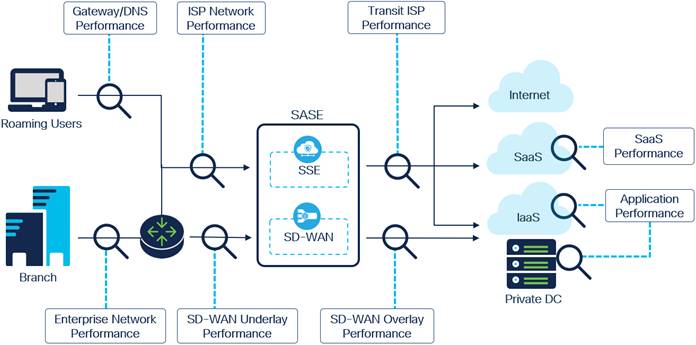
Digital Experience Monitoring Overview
The Digital Experience Monitoring component of a SASE or SSE architecture should have the following qualities:
● Provide metrics to improve the Digital Experience for users no matter where they are or what application they are using
● Provide lower Mean Time to Identification (MTTI) of issues
● Eliminate wasteful finger-pointing between teams
● Hold providers accountable and get swift resolutions
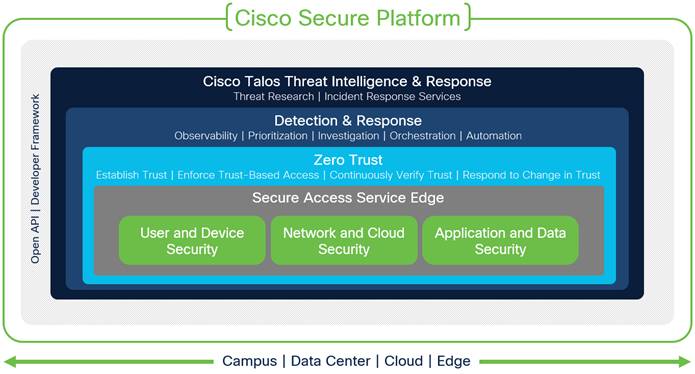
Cisco Secure Framework
Security is not a one-size-fits-all solution. To help understand the architecture, Cisco has broken it down into three pillars:
● User and Device Security: making sure users and devices can be trusted as they access systems, regardless of location
● Network and Cloud Security: protect all network resources on-prem and in the cloud, and ensure secure access for all connecting users
● Application and Data Security: preventing unauthorized access within application environments irrespective of where they are hosted
The Cisco SASE/SSE Architecture incorporates the principles of zero trust to create a comprehensive solution to secure all access to applications from any user, device, and location. Furthermore, the architecture is enhanced by extended detection and response (XDR) and Threat Intelligence technologies.
This architecture guide primarily focuses on securing these three pillars from a SASE/SSE perspective using SAFE. For more information on Cisco Zero Trust security, refer to the Cisco Zero Trust Architecture Guide.
SAFE uses the concept of business flows to simplify the analysis and identification of threats, risks, and policy requirements for effective security. This enables the selection of very specific capabilities necessary to secure them. This is a sample set of business flows. Additional detailed business flows can be found in Appendix C.
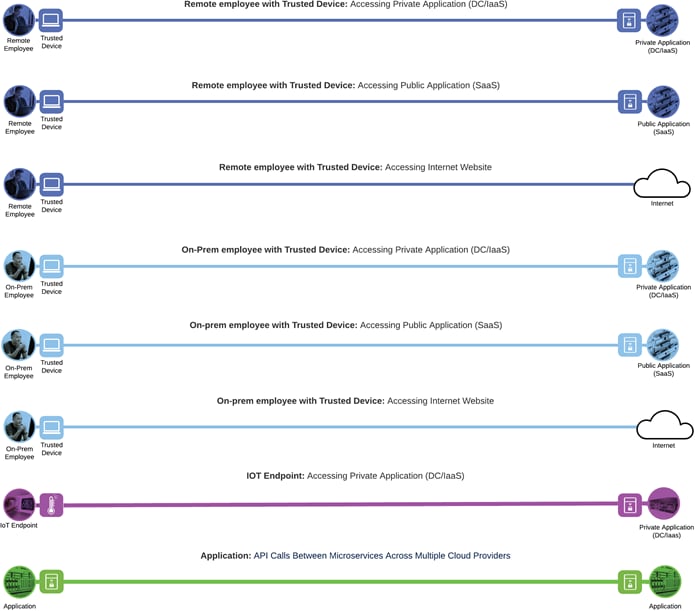
SASE/SSE Business Flows
The next step in the SAFE methodology is to identify the threats for each business flow. This is the attack surface, and the mitigation of these threats is the business problem to be solved.
User and Device
User and Device Security provides solutions that establish trust in users and devices through authentication and continuous monitoring of each access attempt, with custom security policies that protect every application.
| Threat Icon |
Threat Name |
Threat Description |
|
|
Rogue Actor |
Attackers can easily steal or compromise passwords via phishing emails sent to users. With stolen credentials, they can log in to work applications or systems undetected and access data. Brute-force attacks involve programmatically trying different credential pairs until they work, another attack that can be launched remotely. Once inside, attackers can move laterally to get access to more sensitive applications and data. |
|
|
Malicious Device |
Devices running older versions of software – such as operating systems, browsers, plugins, etc. – can be susceptible to vulnerabilities not patched by software vendors. Without those security patches, devices that access work applications and data can introduce risks by increasing the overall attack surface. |
|
|
Insecure Unmanaged Device (BYOD) |
Often, devices that are not owned or managed by your IT team can have out-of-date software and lax security.
Devices that do not have certain security features enabled – such as encryption, firewalls, passwords, etc. – are considered riskier or potentially out of compliance with data regulation standards that require encryption, like healthcare industry compliance standards. |
Network and Cloud
Network and Cloud Security enables users to securely connect to your network from any devices, anywhere while restricting access from non-compliant devices. Automated network-segmentation capabilities enable administrators to set policy for users, devices, and application traffic without requiring network redesign.
| Threat Icon |
Threat Name |
Threat Description |
|
|
Data Exfiltration |
Suspect data loss occurs when an abnormal amount of data has been transferred out of the network. Suspect data hoarding occurs when an inside host is found downloading an abnormal amount of data from other inside hosts. |
|
|
Exploitation |
Hosts attempting to compromise each other, such as through worm propagation and brute force password cracking. |
|
|
Malicious Insider |
An unknown host on the network, or a host that has been compromised and has attempted deviant communication, such as reaching out to a command-and-control server. |
Application and Data
Application and Data Security secures connections for all APIs, microservices, and containers that access applications, whether in the cloud, data center, or other virtualized environment. Enterprise networks are increasingly becoming more complex as applications move to multi-cloud and leverage containers and microservices, effectively creating new security, reporting, and compliance challenges.
| Threat Icon |
Threat Name |
Threat Description |
|
|
Advanced Threats |
For example, a malicious actor, on the public network, exploits a PHP Code Injection vulnerability on the web application and gains access to the details of the underlying operating system and installed packages.
The attacker then exploits a known vulnerability in the underlying operating system or the installed package to perform privilege escalation and then goes on to establish a command-and-control channel to a malicious server running on attacker’s network by remotely executing a piece of code.
The attacker then starts profiling the application environment and exfiltrates sensitive data out through the established command-and-control channel over an outbound UDP 53 port (DNS protocol). |
|
|
Malware |
Zero-day malware attacks, poorly developed applications or unpatched applications are all attack vectors that can be exploited by threat actors. If not protected, the attacker can push malicious code in the source repository resulting in infected software and potential propagation. |
|
|
Malicious Insider |
Without appropriate network visibility and segmentation policies, unknown users / applications may exist in the network or known applications may deviate from characteristic behavior. Malicious actors can take advantage of a flat network with little to no visibility and infiltrate the network without triggering suspicion.
|
Cisco SAFE Business Flows – Threat Vectors

SASE/SSE Business Flows with threats
The Cisco SASE/SSE Architecture is defined using the Cisco SAFE methodology. For more information on SAFE please go to cisco.com/go/safe.
Common Capabilities
The following common capabilities are included in Cisco SASE and SSE.
| Capability Name |
Capability Description |
|
| Anomaly Detection |
Anomaly detection maintains complex models of what is normal, and, in contrast, what is anomalous. Not all anomalous traffic is malicious, and therefore deviations in the network are classified into event categories to assign severity to the anomalies. |
|
|
|
DNS, DHCP, and IP Address Management (DDI) |
DDI is a unified service or solution that centralizes management of DNS and DHCP services and has an IP address management component. Some benefits include visibility and control of these components from a single pane of glass while improving security, resiliency, and support. |
| Flow Analytics |
Network Detection and Response (NDR) solutions leverage pre-existing infrastructure to offer enterprise-wide, contextual visibility of network traffic. Flow information can be used to conduct forensic analysis to aid in lateral threat movement investigations, ensure ongoing zero trust verification is provided, and modern tools can even detect threats in encrypted traffic. |
|
| Security Orchestration Automation & Response (SOAR) |
SOAR is a set of technologies that enable organizations to collect information monitored by the security operations team. |
|
| Threat Intelligence |
Knowledge of emerging threats from active adversaries is shared with solutions that will utilize the information to protect the organization. |
Secure Access Service Edge
The SASE Security Capability group includes the Digital Experience Monitoring and SD-WAN capabilities, and the Secure Service Edge security capability group.
Digital Experience Monitoring

Digital Experience Monitoring (DEM) addresses user experience, human or machine, across every dependency, whether network or service, inside or outside your organization. DEM looks at the entire digital journey and how every part of it drives successful user actions. By focusing on visibility into digital experience as a whole, DEM helps bridge IT initiatives to business outcomes.
SD-WAN

Provides a replacement for traditional WAN routers and are agnostic to WAN transport technologies. SD-WAN provides dynamic, policy-based, application path selection across multiple WAN connections and supports service chaining for additional services such as WAN optimization and firewalls.
Security Service Edge
The Security Service Edge security capability group includes the DNS-layer security capabilities and the following security capability groups:
● Cloud Access Security Broker
● Firewall as a Service
● Secure Web Gateway
● Zero Trust Network Access
Cloud Access Security Broker

An intermediary between cloud providers, cloud-based applications, and cloud consumers to enforce an organization’s security policies and usage.
| Capability Icon |
Capability Name |
Capability Description |
|
|
Application Visibility & Control (AVC) |
Visibility and access control to approved web applications. |
|
|
Data Loss Prevention (DLP) |
Data Loss Prevention (DLP) is designed to stop sensitive information from leaving an organization. The goal is to stop information such as intellectual property, financial data, and employee or customer details from being sent, either accidentally or intentionally, outside the corporate network. |
DNS-layer Security

DNS security enforces security at the DNS layer to block malware, phishing, and command and control callbacks over any port.
Firewall as a Service

Organizations are embracing direct internet access instead of backhauling traffic to the data center. FWaaS provides cloud delivered firewall services without the need to deploy, maintain, and upgrade physical or virtual appliances at a site.
| Capability Icon |
Capability Name |
Capability Description |
| Firewall |
Macro segmentation is the process of separating a network topology into smaller sub-networks, often known as zones. A firewall is typically the enforcement point between zones in a network. |
|
| Intrusion Prevention |
An intrusion prevention system (IPS) provides network visibility, security intelligence, automation, and advanced threat protection. |
|
| Remote Access as a Service |
Enables users who are working remotely to securely access and use applications and data that reside in the enterprise data center and headquarters, encrypting all traffic the users send and receive. |
Secure Web Gateway

Secure Web Gateway protects your network against unwanted software or malware users may encounter on the web. It does this by granting your IT or SecOps team granular control over what users on the company network can do while online.
| Capability Icon |
Capability Name |
Capability Description |
| Malware Sandbox |
Inspects and analyzes suspicious files and URLs and their associated artifacts. |
|
| Network Anti-Malware |
Advanced malware’s goal, in general, is to penetrate a system and avoid detection. Once loaded onto a computer system, advanced malware can self-replicate and insert itself into other programs or files, infecting them in the process. Anti-malware protection should be implemented in both the network (to prevent initial infection and detect attempts of spread) and in the endpoint (to prevent endpoint infection and remove unwanted threats). This capability represents network anti-malware. |
|
| Remote Browser Isolation (RBI) |
Provides an added layer of protection against browser-based security threats for high-risk users. RBI moves the most dangerous part of browsing the internet away from the end user’s machine and into the cloud. |
|
| TLS/SSL Decryption |
Ability to decrypt and inspect encrypted web traffic and block hidden attacks. |
|
| Web Reputation Filtering |
Compares each new website visited against known sites and then blocks access to sites that launch malicious code. |
|
| Web Security |
A full proxy that can log and inspect all your web traffic for greater transparency, control, and protection. IPsec tunnels, PAC files and proxy chaining can be used to forward traffic for full visibility, URL and application-level controls, and advanced threat protection. |
Zero Trust Network Access

Zero Trust Network Access allows organizations to provide granular and adaptive access controls to public and private applications. Lateral movement is prevented through application layer segmentation while user experience is improved due to traffic not being backhauled through a data center.
| Capability Icon |
Capability Name |
Capability Description |
| Application Segmentation |
Least privilege access involves giving users and devices access to only the resource required. Often, network segmentation stops at layer 2 or 3 (Data link and Network layers, respectfully) of the OSI model. Application segmentation involves segmenting and preventing lateral movement at layer 7 of the OSI model or the Application Layer. |
|
|
|
Device Posture Assessment |
The device posture assessment analyzes the device and assesses its security posture, and reports it to the policy decision management system. |
| Identity Authorization |
Establish trust by verifying user and device identity at every access attempt. Least privilege access should be assigned to every user and device on the network, meaning only the applications, network resources and workload communications that are required should be permitted. |
|
| Multi-Factor Authentication (MFA) |
Authentication based on usernames and passwords alone is unreliable since users may have trouble storing, remembering, and managing them across multiple accounts, and many reuse passwords across services and create passwords that lack complexity. Passwords also offer weak security because of the ease of acquiring them through hacking, phishing, and malware. Multi-factor authentication (MFA) requires extra means of verification that unauthorized users will not have. Even if a threat actor can impersonate a user with one piece of evidence, they will not be able to provide two or more. |
|
| SAML & SSO |
Security Assertion Markup Language (SAML) is an open standard that simplifies the login experience for users. It lets them access multiple applications with one set of credentials, usually entered just once. SAML is the underlying technology that links applications with trusted identity providers. |
Endpoint Security

Endpoint security solutions protect endpoints such as mobile devices, desktops, laptops, and even medical and IoT devices. Endpoints are a popular attack vector, and the goal of an attacker is to not only compromise the endpoint but also to gain access to the network and the valuable assets within.
Security practices such as turning on disk encryption, disabling automatic login, and installing anti-virus help ensure an endpoint is “healthy” when joining the network or accessing an application.
| Capability Name |
Capability Description |
|
| Anti-Malware |
Advanced malware’s goal, in general, is to penetrate a system and avoid detection. Once loaded onto a computer system, advanced malware can self-replicate and insert itself into other programs or files, infecting them in the process. Anti-malware protection should be implemented in both the network (to prevent initial infection and detect attempts of spread) and in the endpoint (to prevent endpoint infection and remove unwanted threats). This capability represents endpoint anti-malware. |
|
| Anti-Virus |
Anti-Virus typically deals with older established threats such as trojans, viruses and worms. Anti-Virus is generally included in Anti-Malware solutions which also can detect new modern day threats. Anti-Malware solutions typically also include Anti-Virus capabilities. |
|
| Device Health Connector |
The device health connector analyzes a device and assesses its security posture, and reports it to the policy decision management system. |
|
| DNS Security Connector |
The DNS security connector enforces security at the DNS layer to block malware, phishing, and command and control callbacks over any port. |
|
| Mobile Device Management (MDM) |
Mobile device management includes software that provides the following functions: software distribution, policy management, inventory management, security management, and service management for smartphones and media tablets. MDM provides endpoint access control based on policies. |
|
|
|
Telemetry Connector |
In a cloud-enabled SASE/SSE architecture, internet traffic is not backhauled through a data center. This can create gaps in visibility due to traditional network monitoring solutions being bypassed. The telemetry connector gathers rich flow context directly from an endpoint on or off premises and provides visibility into network connected devices and user behaviors by exporting flow records to a telemetry collector. |
| Web Security Connector |
The Web security connector redirects all web traffic to a full web proxy that provides secure web gateway security services. |
Zero Trust Network Segmentation

Zero Trust Network Segmentation is a security solution that enforces network segmentation policies on user and device traffic that access the network after verifying their identity and context.
| Capability Icon |
Capability Name |
Capability Description |
|
|
Device Posture Assessment |
The device posture assessment analyzes the device and assesses its security posture, and reports it to the policy decision management system. |
|
|
Identity Access Policy |
Policies that control tag assignment and allowed communication between tagged traffic on network devices such as switches and firewalls. For example, Security Group Access Control List (SGACL). |
| Identity Authorization |
Establish trust by verifying user and device identity at every access attempt. Least privilege access should be assigned to every user and device on the network, meaning only the applications, network resources and workload communications that are required should be permitted. |
|
| Tagging |
Segmentation using Endpoint Groups (EPG), TrustSec Security Group Tag (SGT), or VLANs. |
WAN/Internet Edge
The following WAN and Internet edge capabilities are included within the Cisco SASE/SSE Architecture.
| Capability Icon |
Capability Name |
Capability Description |
|
|
Distributed Denial of Service (DDoS) Mitigation |
Provides protection against a cyber-attack in which the perpetrator seeks to make a machine or network resource unavailable to its intended users by temporarily or indefinitely disrupting services of a host connected to the Internet. |
| Web Application Firewall (WAF) |
A Web Application Firewall (WAF) protects websites from application vulnerability exploits like SQL injection, cross-site scripting (XSS), cross-site request forgery, session hijacking, and other web attacks. |
Data Center Security

Data center security is the practice of applying security controls to the data center with the goal of protecting it from threats that could compromise the confidentiality, integrity, or availability of business information assets or intellectual property. Data center security follows the workload across physical data centers and multi-cloud environments to protect applications, infrastructure, data, and users. The practice applies to traditional data centers as well data centers in the public cloud.
Because the focus of this guide is on SASE/SSE, details regarding securing the data center are limited in scope. More detail information about securing the data center can be found in the Secure Data Center Design Guide.
| Capability Icon |
Capability Name |
Capability Description |
|
|
Application Visibility & Control (AVC) |
Visibility and access control to approved web applications. |
|
|
Data Loss Prevention (DLP) |
Data Loss Prevention (DLP) is designed to stop sensitive information from leaving an organization. The goal is to stop information such as intellectual property, financial data, and employee or customer details from being sent, either accidentally or intentionally, outside the corporate network. |
|
|
Firewall |
Macro segmentation is the process of separating a network topology into smaller sub-networks, often known as zones. A firewall is typically the enforcement point between zones in a network. |
|
|
Intrusion Prevention |
An intrusion prevention system (IPS) provides network visibility, security intelligence, automation, and advanced threat protection. |
| Malware Sandbox |
Inspects and analyzes suspicious files and URLs and their associated artifacts. |
|
| Network Anti-Malware |
Advanced malware’s goal, in general, is to penetrate a system and avoid detection. Once loaded onto a computer system, advanced malware can self-replicate and insert itself into other programs or files, infecting them in the process. Anti-malware protection should be implemented in both the network (to prevent initial infection and detect attempts of spread) and in the endpoint (to prevent endpoint infection and remove unwanted threats). This capability represents network anti-malware. |
Application Workload Security

Application Workload Security includes measures at the application level that aim to prevent data or code within the application from being stolen or hijacked. It encompasses the security considerations that happen during application development and design, but it also involves systems and approaches to protect applications after they get deployed.
All application servers should be hardened and follow security practices such as disabling root access, using SNMPv3 instead of SNMPv2, enabling certificate-based authentication for web clients, etc.
| Capability Icon |
Capability Name |
Capability Description |
|
|
Application Dependency Mapping |
Creates a map of all the components of an application. enables network admins to build tight network security policies based on various signals such as network flows, processes, and other side information like load balancer configs. |
| Continuous Vulnerability Scanning |
Continuously acquire, assess, and take action on new information in order to identify vulnerabilities, remediate, and minimize the window of opportunities for attackers. |
|
| Micro-Segmentation |
Micro-segmentation secure applications by expressly allowing particular application traffic and, by default, denying all other traffic. Granular east-west policy control provides a scalable way to create a secure perimeter zone around each workload with consistency across different workload types and environments. |
|
| Patch Management |
The systematic notification, identification, deployment, installation, and verification of operating system and application software code revisions. These revisions are known as patches, hot fixes, and service packs. |
|
| Policy Generation, Audit & Change Management |
The output of application dependency mapping provides an allowed access list policy. This policy will need to be audited and changed as required. |
|
| Process Anomaly Detection & Forensics |
Anomaly detection is provided by performing hash analysis of all httpd binaries on the system, and reporting any mismatches. For all processes across the workloads if the rootscope, executable binary path, OS version or package info does not match the expected value, it is reported. Forensics enables monitoring and alerting for possible security incidents by capturing real-time forensic events and applying user-defined rules. |
|
| Runtime Application Security Protection |
A security technology that is built or linked into an application or application runtime environment, and is capable of controlling application execution and detecting and preventing real-time attacks. |
|
|
|
Tagging |
Segmentation using Endpoint Groups (EPG), TrustSec Security Group Tag (SGT), or VLANs. |
Cisco SAFE Business Flows - Capability Mappings
Not all business flows have the same requirements. Some use cases are subject to a smaller attack vector and therefore require less security to be applied. Some have larger and multiple vectors and require more. Evaluating the business flow by analyzing the attack surfaces provides the information needed to determine and apply the correct capabilities for flow specific and effective security. This process also allows for the application of capabilities to address risk and administrative policy requirements.

SASE/SSE Business Flows with SAFE Capabilities
SASE/SSE Reference Architecture
The Cisco SAFE Security Reference Architecture below includes the main architectural components needed to deliver the security capabilities for each pillar. The Cisco SAFE Reference Architecture is included in the Cisco Security Reference Architecture and is presented below in that format and merged with the SAFE methodology.

Cisco SAFE Security Reference Architecture
The Cisco SASE/SSE Architecture below includes the architectural components needed location-by-location to deliver the security capabilities for each pillar and is structured as follows:
● SASE (SD-WAN + SSE + DEM) and Cloud Security (Top)
● Consumers (Left)
◦ On-prem employees and IoT devices located at a Campus
◦ Remote Employees located at their Home Office or Public Location
◦ On-prem employees and IoT devices located at a Small Branch
● Providers (Right)
◦ Private applications located in Cloud Workloads (IaaS)
◦ Private applications located in a private Data Center
◦ Internet Website
◦ Public Application (SaaS)
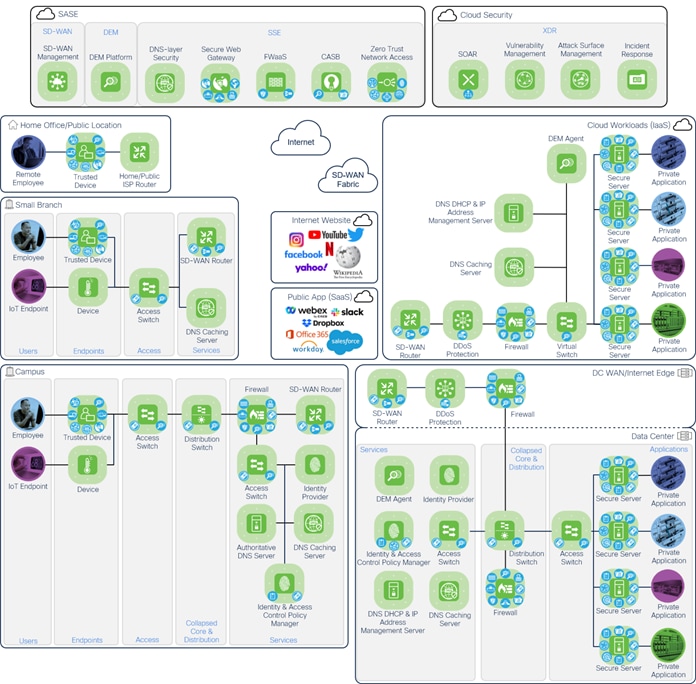
Cisco SASE/SSE Reference Architecture
User and Device Security
Security in this pillar involves making sure users and devices can be trusted as they access applications, workloads, and data, regardless of location. With a hybrid workforce, users may be located on-premises at a branch, at home, or a coffee shop. Regardless of their location, it is imperative that they are identified and have the appropriate context before accessing company resources.
Identity involves the authentication, authorization, and accounting of entities accessing resources to confirm they are who they say they are, they will only have access to the resources they need, and their access attempt is logged in case there is a breach. For roaming users, this is done using ZTNA or RAaaS with the primary factor of authentication using an identity provider such as Microsoft Active Directory but should be enhanced through mechanisms such as MFA. On-prem users are identified with 802.1x before they are allowed to access the network. User experience for both roaming and on-prem users can be improved by enabling SAML and SSO for private and public applications, minimizing password exhaustion for users who have the option of signing into multiple services using a single set of credentials. Along with identity, context is also important before access is allowed. Device posture and other risk-based assessment checks against the device such as if the browser or anti-virus definitions are out-of-date can prevent risker devices from accessing the network.
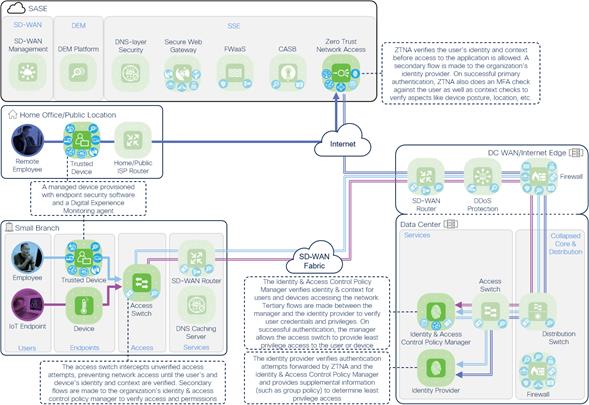
SASE/SSE User & Device Security Business Flows with SAFE Capabilities
With managed devices, there is option to install endpoint security software to lower the risk of compromise to devices connecting to trusted and untrusted networks. This software adds anti-malware security capabilities to prevent and remove threats, connectors needed to forward traffic to the SASE or SSE cloud for inspection and policy enforcement, and more. For visibility into the user’s digital experience, an agent is installed onto the managed device to monitor application performance from the user’s perspective, providing additional assistance to IT teams troubleshooting connectivity issues that user may experience. A cloud-based mobile device management (MDM) solution can be used to distribute software, including endpoint security software, and manage security policies on the device no matter where they are located.
When using an unmanaged device, such as a personal smartphone or PC, the user can verify their identity using MFA and simpler context checks can be done, however, there is no insight into what services are running on the device. Network controls must be put in place to limit network access and to detect suspicious traffic patterns.
Users are not the only endpoints connected to the network. IOT Endpoints such as lighting, heating and air conditioning have changed the way security must be enforced on the network. These devices are not only absent a user, but many do not have the capability to leverage an 802.1X supplicant or a Certificate. In this case, context checks such as posture and device profiling assessments can be used to control devices as they connect to the network. Typically, the device MAC address is used to uniquely identity the device, and a profile is built using information such as:
● Is the device secured using a strong method of authentication?
● What are the services it is trying to connect to?
● What ports is the device communicating on?
All of which allows us to build control policies and assign identifying tags to the devices traffic as it communicates across the network.
Network and Cloud Security
After successful identity and context verification, user or device traffic must be routed to a public SaaS application, private application within a datacenter or IaaS environment, or public Internet website. The Network and Cloud security pillar handles providing secure transport for user, device, and application traffic as it is routed over insecure underlay networks while enforcing the organization’s security policy to prevent unauthorized access to protected applications and sensitive data. Traffic destined to public SaaS applications or internet websites is routed through the SASE/SSE cloud where cloud security services are performed. Traffic destined to private applications is routed through on-premises access where traditional on-premises security services are applied.
For roaming users accessing public or private applications, least privileged access is provided by a ZTNA solution after identity and context verification. As an initial step to accessing the application, the DNS request for the application is verified using DNS security protecting the user from phishing attempts using similar looking URLs. Traffic is proxied through the SASE/SSE cloud to provide security and enforce company policies for web-based traffic (SWG), non-web traffic (FWaaS), and provide data loss prevention (CASB). ZTNA does per application segmentation, preventing lateral movement by the user. For private applications in the data center or IaaS environment, traffic is appropriately tagged and monitored as it passes through the network. Firewalls enforce the security policy set by the identity & access control policy manager. For public SaaS applications, access is monitored for any abnormal behavior by the CASB. Public Internet websites accessed by the user, such as YouTube, don’t require identity checks controlled by the organization, however for managed devices DNS security and SWG can be used to restrict access to insecure or inappropriate websites. Inline DLP can prevent data loss and FWaaS can filter non-web traffic and provide intrusion prevention for inbound traffic.
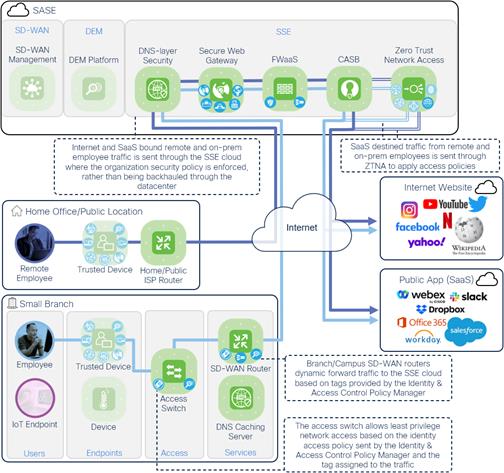
SASE/SSE Network & Cloud Security (Internet/SaaS) Business Flows with SAFE Capabilities
Alternatively, roaming users can connect to private applications using RAaaS services within SSE. This could be for accessing legacy apps, or ones difficult to re-architect for SSO or Zero Trust model compatibility. Managed devices (or unmanaged devices with an installed VPN client) may access the network over an encrypted tunnel as if they were sitting on the corporate network. While some applications suit a ZTNA implementation, more sensitive applications may require the extra layer of protection an IPsec tunnel would provide. Access could, through the security policy, be limited to managed devices, where endpoint security software can be installed to protect sensitive data from compromised devices. Like ZTNA, identity and context should still be verified and least privilege access should be implemented through mechanisms like split tunneling and tagging. Split tunneling will route only IP traffic associated with the specified application over the tunnel while enforcing tagging will limit lateral movement.
For on-prem users and IOT devices, least privileged access is enforced by network devices in the branch and data center (SD-WAN routers, switches, and firewalls) after identity and context verification. After verification of the DNS requests, traffic from these users and devices is tagged and segmentation is applied based on the identity access policy distributed by the identity and access policy manager. For private applications in the data center or IaaS environment, SD-WAN routers securely route traffic to remote locations over underlay networks using IPsec tunnels while maintaining tags and segmentation. Firewalls within the data center environment enforce the security policy, blocking unauthorized access and checking for malware or intrusion attempts. For internet bound traffic (SaaS or public website), like roaming users, DNS requests initiated by on-prem employees is verified by DNS security as an initial step. After DNS security verifies the domain is safe, a DNS reply is sent, and the Internet bound traffic is forwarded to the SASE/SSE cloud by the SD-WAN router. The SASE/SSE service provides security and enforces security policies for web-based traffic (SWG), non-web traffic (FWaaS), and provides data loss prevention (CASB).
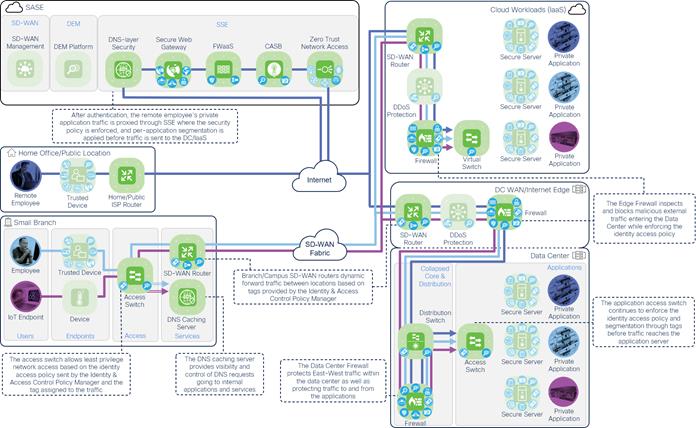
SASE/SSE Network & Cloud Security (Private Application) Business Flows with SAFE Capabilities
Finally, a digital monitoring experience agent is installed at the branch, data center, and IaaS environment to monitor ISP and SD-WAN performance close to the users and close to the hosted private applications used by employees.
Application and Data Security
While organizations can benefit from the scale and agility offered by hosting applications within hybrid and multi-cloud environments, difficulties arise with managing the security of these distributed applications. For example, with applications running across multiple infrastructures comes an increased attack surface. The Application and Data Security pillar focuses on the security capabilities needed to prevent unauthorized access whether those applications or workloads are hosted in the data center or in the cloud. Along with user-to-application traffic, Application and Data Security must also be enforced for application-to-application traffic where there may be API calls and other communications between microservices or containers.
Traffic to these applications initially passes a web application firewall which monitors and filters web-based traffic for exploits and malicious connection attempts. DDoS protection blocks attempts to overwhelm the application server and disrupt service availability. Successful DDoS attacks can cause productivity loss as well as revenue loss for applications necessary for sales while successful exploits against the application servers can allow exfiltration of sensitive customer data or software code.
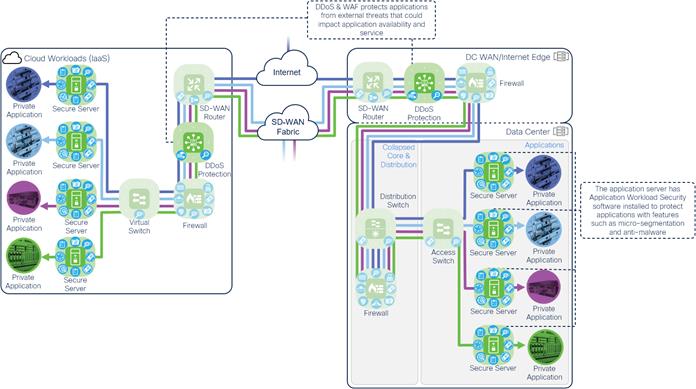
SASE/SSE Application & Data Security Business Flows with SAFE Capabilities
On the application server, an anti-malware software agent is deployed to provide defense in depth, preventing and removing malicious threats not detected by endpoint security software, SASE/SSE, or network firewalls. For comprehensive security, workload protection software should be deployed to on the server including features such as:
● Micro-segmentation to reduce the attack surface for application traffic and only allowing known and required communications
● Visibility into application behaviors, dependencies, and vulnerabilities as this is important for baselining normal behavior to quickly identify abnormal or suspicious behavior
● Continuous vulnerability scanning to allow for quick detection and quarantining of workloads affected by risky vulnerabilities
Through these features, the attack surface of distributed applications is reduced, lateral movement is minimized in the event of a security incident, and the identification of anomalies and suspicious behavior is accelerated.
Appendix A – SASE/SSE Reference Architecture Security Capabilities
Considering the architecture discussed in the previous section of this document, all the capabilities and Cisco/Cisco Partner solutions can be mapped as below.
| Capability Icon |
Capability Name |
Cisco/Cisco Partner Security Solution |
|
|
Anomaly Detection |
Cisco Secure Network Analytics Cisco Cyber Vision Cisco Secure Cloud Analytics Cisco Duo |
|
|
Anti-Malware |
Cisco Secure Endpoint (integrated with Secure Connect, Secure Access, Firewall & SD-WAN) Cisco Secure Malware Analytics |
|
|
Anti-Virus |
Cisco Secure Endpoint (integrated with Secure Connect, Secure Access, Firewall & SD-WAN) Cisco Secure Malware Analytics |
|
|
Application Dependency Mapping |
Cisco Secure Workload |
|
|
Application Segmentation |
Cisco Secure Connect Duo Network Gateway |
|
|
Application Visibility & Control (AVC) |
Cisco Secure Access Cisco Secure Firewall Cisco Secure Workload Cisco AppDynamics Cisco Secure Application Cisco Secure Web Appliance Cisco Cloudlock Cisco Meraki Cisco Secure Connect |
|
|
Asset Management |
Cisco Secure Cloud Insights |
|
|
Cloud Access Security Broker (CASB) |
Cisco Secure Access Cisco Cloudlock Cisco Secure Connect |
|
|
Continuous Vulnerability Scanning |
Cisco Secure Workload |
|
|
Data Loss Prevention (DLP) |
Cisco Cloudlock Cisco Secure Access Cisco Secure Connect |
|
|
Distributed Denial of Service (DDoS) Mitigation |
Radware DDoS |
|
|
Device Health Connector |
Cisco Duo Device Health |
|
|
Device Posture Assessment |
Cisco Identity Services Engine Cisco Duo Cisco Secure Firewall Cisco Secure Connect |
|
|
Digital Experience Monitoring (DEM) |
ThousandEyes |
|
|
DNS, DHCP, and IP Address Management (DDI) |
BlueCat Integrity |
|
|
DNS Security |
Cisco Secure Access Cisco Secure Connect BlueCat Edge |
|
|
DNS Security Connector |
Cisco Secure Client (AnyConnect) Cisco Secure Access Virtual Appliance |
|
|
Firewall |
Cisco Secure Firewall Cisco Secure Access Cisco Secure Workload Cisco Meraki MX Cisco Secure Connect |
|
|
Flow Analytics |
Cisco Cyber Vision Cisco Secure Network Analytics Cisco Secure Cloud Analytics Cisco Secure Workload |
|
|
Identity Access Policy |
Cisco Identity Services Engine |
|
|
Identity Authorization |
Cisco Duo Cisco Identity Services Engine Cisco Secure Connect |
|
|
Intrusion Prevention |
Cisco Secure Firewall Cisco Secure Access Cisco Secure Connect |
|
|
Malware Sandbox |
Cisco Secure Malware Analytics |
|
|
Micro-Segmentation |
Cisco Identity Services Engine Cisco Secure Workload Cisco Secure Application |
|
|
Mobile Device Management (MDM) |
Cisco Meraki Systems Manager |
|
|
Multi-Factor Authentication (MFA) |
Cisco Duo |
|
|
Network Anti-Malware |
Cisco Secure Firewall Cisco Secure Access Cisco Meraki MX Cisco Secure Email Appliance Cisco Secure Web Appliance Cisco Secure Connect |
|
|
Patch Management |
Cisco Secure Workload |
|
|
Policy Generation, Audit & Change Management |
Cisco Secure Workload |
|
|
Process Anomaly Detection & Forensics |
Cisco Secure Workload |
|
|
Remote Access VPN |
Cisco Secure Firewall (ASA (Adaptive Security Appliance)) Cisco Secure Firewall (FTD (Firepower Threat Defense)) Cisco Meraki MX Cisco Secure Connect |
|
|
Remote Browser Isolation (RBI) |
Cisco Secure Access |
|
|
Runtime Application Security Protection |
Cisco Secure Application |
|
|
SAML & SSO |
Cisco Duo Cisco Secure Connect |
|
|
SD-WAN |
Cisco Meraki Cisco Viptela |
|
|
Security Orchestration Automation & Response (SOAR) |
Cisco SecureX |
|
|
Tagging |
Cisco Secure Workload |
|
|
Telemetry Connector |
Cisco Secure Client (AnyConnect) |
|
|
Threat Intelligence |
Cisco Talos |
|
|
TLS/SSL Decryption |
Cisco Secure Firewall Cisco Secure Access Cisco Secure Connect Radware Alteon |
|
|
Vulnerability Management |
Cisco Kenna Cisco Secure Workload |
|
|
Web Application Firewall (WAF) |
Radware WAF Radware kWAF |
|
|
Web Reputation Filtering |
Cisco Secure Access Cisco Secure Web Appliance Cisco Secure Connect |
|
|
Web Security |
Cisco Secure Access Cisco Secure Web Appliance Cisco Secure Connect |
|
|
Web Security Connector |
Cisco Secure Client (AnyConnect) |
Appendix B – SASE/SSE Reference Design
The following is the Cisco SAFE Security Reference Design which identifies the products that deliver the security capabilities required in the Cisco SASE/SSE Reference Architecture.

Cisco SAFE Security Reference Design
The Cisco Unified SASE Design below identifies the products that deliver the security capabilities required location-by-location in the Cisco SASE/SSE Reference Architecture. A unified SASE solution is more than just a SaaS service provided by a single vendor that provides all SASE network (SD-WAN) and security (DNS-layer security, SWG, FWaaS, CASB, ZTNA) capabilities within a single product. A unified SASE design must also be highly integrated and provide ease of management. Some of the benefits of a unified SASE design are:
● Unified management allowing for efficient creation and deployment of network and security policies
● Improved user experience through consistent security policy enforcement regardless of the user’s location
● Improved visibility with integrated SASE components due to unified data
This unified SASE design uses Cisco Secure Connect for the primary SASE security capabilities and is complemented by Cisco Duo for MFA and Cisco ThousandEyes for DEM. The hardware model numbers for SD-WAN routers are only mentioned for reference. Further analysis is required to determine the correct hardware model for your sites.

Cisco Unified SASE Design
The Cisco Modular SASE/SSE with Self-Hosted ZTNA & Remote Access Design below also identifies products that deliver the security capabilities required location-by-location in the Cisco SASE/SSE Reference Architecture. Unlike the unified SASE design, this design provides more flexibility for choosing different products for each security capability at the expense of integration and compatibility between products. Still, this design can allow organizations to gradually modify their network rather than moving to a full SASE or SSE architecture all at once. Still, a single vendor unified SSE offers benefits over disparate SSE solutions. These benefits can include:
● Consistent and easier security policy enforcement as all user traffic will get routed through the same SSE cloud for SWG, FWaaS, and CASB functions
● Unified security policy management through a single pane of glass
● Single agent deployment on managed devices, simplifying security software deployment and maintenance
At this time, Cisco’s solution for unified SSE uses Secure Access for DNS-layer security, SWG, FWaaS, and CASB security functions but ZTNA and/or Remote Access VPN solutions must be self-hosted. Hardware model numbers for SD-WAN routers are only mentioned for reference. Further analysis is required to determine the correct hardware model for your sites.

Cisco Modular SASE/SSE with Self-Hosted ZTNA & Remote Access Design
Appendix C – SASE/SSE Detailed Business Flows with Capabilities

Remote Employee with Trusted Device: Clientless ZTNA - Accessing Private Application (web/ssh/rdp) (DC/IaaS)

Remote Employee with Trusted Device: Remote Access - Accessing Private Application (any tcp/udp) (DC/IaaS)

Remote Employee with Trusted Device: Accessing Public Application (SaaS)

Remote Employee with Trusted Device: Accessing Internet Website

On-prem Employee with Trusted Device: Accessing Private Application (DC/IaaS)

On-prem Employee with Trusted Device: Accessing Public Application (SaaS)

On-prem Employee with Trusted Device: Accessing Internet Website

IoT Endpoint: Accessing Private Application (DC/IaaS)

Application: API calls between microservices across Multiple Cloud Providers

Appendix D – Acronyms Defined
Considering the design discussed in previous sections of this document, all the capabilities and Cisco solutions corresponding to each capability can be mapped as below.
| Definition |
|
| AD |
Active Directory |
| API |
Application programming interface |
| ASA |
Adaptive Security Appliance |
| AVC |
Application Visibility and Control |
| AWS |
Amazon Web Services |
| BYOD |
Bring Your Own Device |
| DC |
Data Center |
| DDI |
DNS, DHCP, and IP Address Management |
| DDoS |
Distributed Denial of Service |
| DEM |
Digital Experience Monitoring |
| DIA |
Direct Internet Access |
| DLP |
Data Loss Prevention |
| DMZ |
Demilitarization Zone |
| DNS |
Domain Name System |
| EPG |
Endpoint Groups |
| Firepower Management Center |
|
| FQDN |
Fully Qualified Domain Name |
| FTD |
Firepower Threat Defense |
| FWaaS |
Firewall as A Service |
| IaaS |
Infrastructure as a Service |
| IoT |
Internet of Things |
| IPS |
Intrusion Prevention System |
| Identity Services Engine |
|
| ISP |
Internet Service Provider |
| MDM |
Mobile Device Management |
| MFA |
Multi-Factor Authentication |
| MPLS |
Multiprotocol Label Switching |
| MTTR |
Mean Time to Repair |
| MTTI |
Mean Time to Identify |
| MX |
Meraki Security |
| NaaS |
Networking as a Service |
| NDR |
Network Detection and Response |
| OS |
Operating System |
| OSI |
Open Systems Interconnection |
| PaaS |
Network Time Protocol |
| PAC |
Network Visibility Module |
| PoP |
Point of Presence |
| RAaaS |
Remote Access as a Service |
| RBI |
Remote Browser Isolation |
| SaaS |
Software as a Service |
| SAML |
Security Assertion Markup Language |
| SASE |
Secure Access Service Edge |
| SD-WAN |
Software Defined Wide Area Network |
| SECaaS |
Security as a Service |
| SGACL |
Security Group Access Control List |
| SGT |
Security Group Tag |
| SIG |
Security Information and Event Management |
| SQL |
Structured Query Language |
| SSE |
Security Service Edge |
| SSL |
Secure Sockets Layer |
| SSO |
Single Sign On |
| SWG |
Secure Web Gateway |
| TLS |
Transport Layer Security |
| URL |
Uniform Resource Locators |
| VLAN |
Virtual Local Area Network |
| VPN |
Virtual Private Network |
| WAF |
Web Application Firewall |
| WAN |
Wide Area Network |
| XDR |
Extended detection and response |
| XSS |
Cross site scripting |
| ZTNA |
Zero Trust Network Access |
Appendix E - References
● Cisco SD-WAN powered by Meraki
● Cisco SD-WAN powered by Viptela
● Cisco Security Refence Architecture
● BlueCat
● Cisco Secure Data Center Architecture Guide
● Cisco Zero Trust Architecture Guide
If you have feedback on this design guide or any of the Cisco Security design guides, please send an email to
ask-security-cvd@cisco.com.





































































